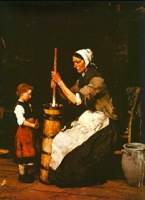Churning
Origin
Middle English chyrne, from Old English cyrin; akin to Old Norse kjarni churn
Definition
- 1:the process of making butter in which milk or cream is agitated in order to separate the oily globules from the watery medium
Description
Churning is the process of shaking up cream (or whole milk) to make butter, and various forms of butter churn have been used for the purpose. In Europe from the Middle Ages until the Industrial Revolution, this was generally as simple as a barrel with a plunger in it, which was moved by hand. Afterward, mechanical means of churning were usually substituted.
Butter is essentially the fat of milk. It is usually made from sweet cream. In the USA, Ireland and the UK, salt is usually added to it. Unsalted (sweet) butters are most commonly used in the rest of Europe. However, it can also be made from acidulated or bacteriologically soured cream. Well into the 19th century butter was still made from cream that had been allowed to stand and sour naturally. The cream was then skimmed from the top of the milk and poured into a wooden tub.
Buttermaking was done by hand in butter churns. The natural souring process is, however, a very sensitive one and infection by foreign microorganisms often spoiled the result. Today's commercial buttermaking is a product of the knowledge and experience gained over the years in such matters as hygiene, bacterial acidifying and heat treatment, as well as the rapid technical development that has led to the advanced machinery now used. The commercial cream separator was introduced at the end of the 19th century, the continuous churn had been commercialized by the middle of the 20th century.
The process can be summarized in 3 steps:
- 1:Churning physically agitates the cream until it ruptures the fragile membranes surrounding the milk fat. Once broken, the fat droplets can join with each other and form clumps of fat, or butter grains.
- 2: As churning continues, larger clusters of fat collect until they begin to form a network with the air bubbles that are generated by the churning; this traps the liquid and produces a foam. As the fat clumps increase in size, there are also fewer to enclose the air cells. So the bubbles pop, run together, and the foam begins to leak. This leakage is called buttermilk.
- 3: The cream separates into butter and buttermilk. The buttermilk is drained off, and the remaining butter is kneaded to form a network of fat crystals that becomes the continuous phase, or dispersion medium, of a water-in-fat emulsion. Working the butter also creates its desired smoothness. Eventually the water droplets become so finely dispersed in the fat that butter’s texture seems dry. Then it is frozen into cubes, then melted, then frozen again into bigger chunks to sell.
